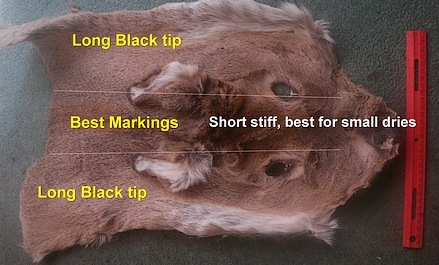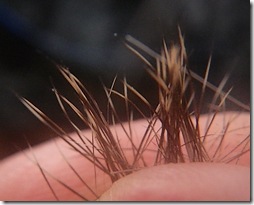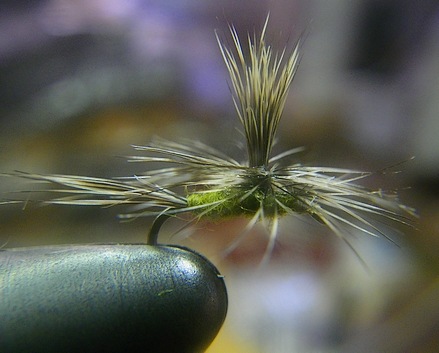I was in one of many petulant moods, lower lip pooched mightily resolved never to play parachute ever again. Every so often I’d produce a decent one, and then it was back to eleven anguished attempts to wrestle balky deer hair into a right-side up configuration just long enough for me to pin it in place with a couple turns of ginger hackle.
Each snapped thread, each spin of the wing, each busted hackle added to my rage, and while I couldn’t quite pin the issue on something obvious, it began to dawn on me that it wasn’t skill or lack of effort, it was some new wrinkle surfacing to thwart me.
It wasn’t rocket science either, I asked one of the fellows tying nearby to assist in diagnosing my obvious shortcomings, and while the both of us watched the hair resist my authoritative attempts at a post, it dawned on me that fly patterns might mention what animal is used, but it doesn’t mention whether it needs to be stiff, floppy, whether it should flair when tied in – or resist that too…
In my case I had a chunk of belly fur off a deer – whose fibers were long and poorly marked, as well as floppy and unable to support the thread base. Every time I attempted to lay a wrap around it for support it would slough the thread right off.
About then I trebled my estimate of the cost of fly tying, now that I was assured that an armload of deer hide was needed. Along with all them colors, I needed to add “well marked” and “stiff” and “ass hair” to the growing list of stuff I was missing.

It’s one of those lessons that adds polish to your future work, and bridges the gap between flies you admire and your own work. Especially so when you can size the markings on the hair to the fly your tying.
All animals have different markings and hair length corresponding to the different parts of the body. Belly hair is the longest and poorly marked (usually too light), and the strip that covers the spine is the darkest and best marked. Hair on the extremities is shorter and stiffer, as is the fine fur of the face and genital area.
The photo above shows a typical deer mask, about two square feet costing around $10, and contains every size and marking coloration on the animal. It’s a great deal for the price, and gives much more hair than is needed allowing you to split the cost with pals, or attempting to learn dyeing with the extra …

Here’s a blowup of the hair in the area marked “long black tip.” If you add only the black tip to the blond bar you already have a wing length equivalent to a size 14.
Worse, the hair is very long and floppy.
If you make a parachute wing of this type of hair it will be difficult to tie correctly (limp), and the long black tip will be hard to see – making the blond area of the wing look much too short. Ditto when fishing, you won’t be able to see those black tips at distance, and you’ll be straining to see the bump or blonde at twilight.
 Contrast the above with the hair available in front of its ears, on its forehead and along its snout.
Contrast the above with the hair available in front of its ears, on its forehead and along its snout.
The black tip is a third the length as is the blond bar. A wing tied with this hair will show all three colors as opposed to the too-long limp hair above.
Because the hair is short it’s super stiff, and will support a parachute post without complaint.

Right-sizing a parachute wing mindful of the bands of color on deer hair makes the fly look complete and tidy. Grabbing fibers off the too-long side would make the above wing half-black and half-blonde, due to the length of their banding. All you could see on the water would be the little nubbin of blonde nearly flush with the waterline.
Unfortunately, so long as the jobbers hold sway on a fly shop’s materials you’ll never be exposed to all the qualities of hair from different parts of the body, largely because a 1 x 1” square of deer hair doesn’t have enough surface area to see the hair transition from neck to shoulder.
It’s these little hints that make you grip someone else’s flies and wonder how his look so much better than yours, and how you wish yours looked similar.
You’ll be quick to understand once exposed to a big expanse of goody.
Note: Most taxidermists cut away the female genitalia, tossing the scrap into the waste basket. Should you be adventurous enough, deer “pooty” can be some of the stiffest and well marked hair on the entire animal.
It’s been washed and treated, just don’t flash it at some tying demo while you’re under the hot lights of the tying theater. Instead wait for your buddy to bare-hand his only sandwich, then you can tell him what he’s fishing.

There are two types of fly that I have never owned enough of: Para-anything and Soft hackle any color. They vanish into the weed beds and low hanging bushes as fast as they are tied on. This article, like many of the others before it, serve to illustrate that each fly lost represents an evolution in craft and experience that a non-tyer cannot even guess at. There is a great deal of humor that might follow this statement but my point is that we fish with more than craft and less than art which we brashly ask for by the fist full.
Pray tell, why deer hair for the post?
Deer hair is hollow and aids flotation, versus a material like calf tail which is a solid hair but does little to assist in floating the fly.
That’s why the choice of where the hair comes from on the hide is so important, you want hair whose markings are appropriately sized, and doesn’t flair.
Are there sections of the deer hair that offer more flotation (through a larger/more hollow core) than others?
B,
Technically yes. The larger and longer hair have a bigger diameter than the smaller fibers, but the real question is can you fit more or less hair on the hook ?
A #14 hook has a finite area to stuff spun deer hair on, I’m not so sure that the larger fiber helps all that much in this instance. A shank full of deer hair might have a similar floatability regardless of what sized fibers are used.
Great post… I have had my issues with deer hair but it is hollow and helps with flotation. I have my deer hides processed so I can select exactly what I need. One good one can last a very long time. Many hunters do not keep the hide so if you can hook up with someone that processes deer you can usually get one free.